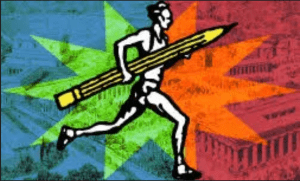The writing marathon has become a mainstay in many Writing Project summer institutes, workshops, and conferences. The goal of a writing marathon is to weave together movement and writing. A writing marathon might have a theme or purpose for visiting particular sites. For example, in 2011 during my Louisville Writing Project summer institute experience, we drove to Civil Rights landmarks. Our writers learned about the events and people they represented, and then reflected and wrote. Similarly, at several conferences and workshops, I have seen hosts conduct walking and writing tours of their home cities.

So how might the writing marathon be modified for the classroom or home when mobility is limited? When conducting a writing marathon in a limited space such as around the classroom or home, consider guiding participants to find inspiring spaces or objects. Lately, scavenger hunts have become popular activities. Similarly, writing can be inspired by reflections about the simplest objects in our local spaces – birds in flight, spring awakening, cracks in sidewalks (where did old wives’ tales come from, anyway?).
Writing Guidelines
Modifying the recommendations of “
A Guide for Writing Marathon Leaders” posted by the
National Writing Project can help.
- Treat the participants as writers. Be a writer.
- Keep the marathon focused on the writing. Sightseeing, tour guide speaking, and socializing take backseat.
- Conduct as many rounds of writing as possible. The walking, talking, reading, or interacting should spur writing, not detract from it.
- Write, read your writing to others, and say only “thank you” after each reading (Natalie Goldberg, whose book Writing Down the Bones).
- Say, “I am a writer.” Really. Do it.
- Keep groups small. In the case of a classroom, 3-4 students writing together is appropriate. At home, write alongside your child or children. Be partners in writing.
- Remember that writing happens even when we’re not writing. The moment the writing marathon has begun with introductions of participants as writers, the mindset has shifted to positive productivity.
- Select an appropriate closure. It might be a select reading of the marathon’s writings. Stay flexible. Participants might not be ready to stop writing at the same time.
- Remember: choice, community, diversity, spontaneity, serendipity, discovery.
- Write for the experience, not the product.
As stated in the Guide, “A writing marathon is all about the writing and writer. Say it again. It is all about the writing and writer. And writing is enjoyable, especially when you do not have to do it for anyone else but yourself, when no one will criticize it, when you give it plenty of time, and when you allow yourself to write about things you did not expect.” Also see this
handout for more tips.
Finally, share your writing marathon experiences as participants and leaders as comments to this post.
We look forward to hearing from you!
 So how might the writing marathon be modified for the classroom or home when mobility is limited? When conducting a writing marathon in a limited space such as around the classroom or home, consider guiding participants to find inspiring spaces or objects. Lately, scavenger hunts have become popular activities. Similarly, writing can be inspired by reflections about the simplest objects in our local spaces – birds in flight, spring awakening, cracks in sidewalks (where did old wives’ tales come from, anyway?).
So how might the writing marathon be modified for the classroom or home when mobility is limited? When conducting a writing marathon in a limited space such as around the classroom or home, consider guiding participants to find inspiring spaces or objects. Lately, scavenger hunts have become popular activities. Similarly, writing can be inspired by reflections about the simplest objects in our local spaces – birds in flight, spring awakening, cracks in sidewalks (where did old wives’ tales come from, anyway?).

